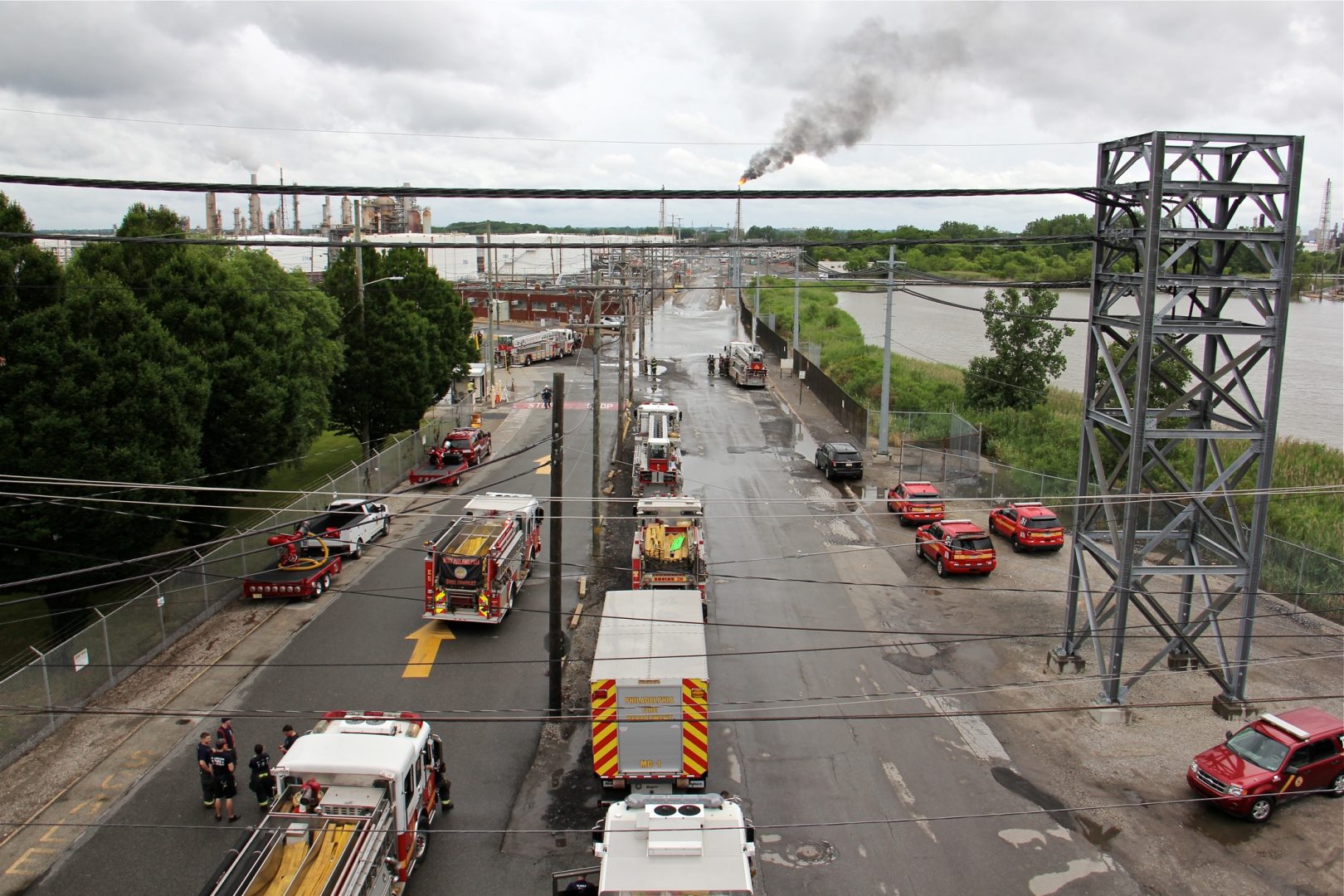
Philadelphia firefighters gather at the entrance to Philadelphia Energy Solutions Refinery, while a large flare burns off fuel to prevent it from feeding the massive fire at the refinery.
Emma Lee / WHYY


Philadelphia firefighters gather at the entrance to Philadelphia Energy Solutions Refinery, while a large flare burns off fuel to prevent it from feeding the massive fire at the refinery.
Emma Lee / WHYY

Emma Lee / WHYY
Philadelphia firefighters gather at the entrance to Philadelphia Energy Solutions Refinery, while a large flare burns off fuel to prevent it from feeding the massive fire at the refinery.
Workers at the Philadelphia Energy Solutions refinery in South Philadelphia are planning to start neutralizing tens of thousands of gallons of a highly toxic chemical beginning Aug. 5. The refinery is shutting down after an explosion and fire destroyed part of the plant. The company has entered Chapter 11 bankruptcy.
The chemical, hydrofluoric acid, is one of the most dangerous industrial substances in use. Refineries use it as a catalyst to create high-octane fuel and it was an integral part of the unit that exploded at PES back in June.
The company’s own risk management plan, filed with the Environmental Protection Agency as a requirement under the Clean Air Act, describes a catastrophic worst-case scenario involving hydrofluoric acid. If 143,262 pounds of hydrogen fluoride were released over 10 minutes, a toxic cloud could travel for more than seven miles and affect more than a million people, including in schools, homes, hospitals, prisons, playgrounds, parks, and a wildlife sanctuary.
The chemical penetrates the skin and reacts with the calcium in bones. Swallowing just a small amount, or getting small splashes on the skin, can be fatal, according to the Centers for Disease Control and Prevention. In its gaseous state, the CDC says, low levels of hydrogen fluoride can irritate the eyes, nose and respiratory tract. Breathing it at high levels “can cause death from an irregular heartbeat or fluid buildup in the lungs.”
A PES spokeswoman said the company does not comment on operations.
James Eninger is a retired engineer who worked with the toxic chemical in the development of high-energy lasers at engineering firm TRW. He now works to convince refineries to stop using it in conjunction with highly flammable hydrocarbons.
“Just to give you an idea of how toxic it is,” said Eninger, “just half an ounce of it, which is about a third of a whiskey jigger, if it were released into a large conference room would potentially kill people.”
Eninger is active with the Torrance Refinery Action Alliance in California, which formed after a 2015 explosion at an ExxonMobile refinery near Los Angeles also caused a near-miss with hydrofluoric acid. He says neutralizing and removing such a large amount of hydrofluoric acid would have to be done “very carefully and with a lot of oversight.”
According to Honeywell, a major manufacturer of the chemical, neutralizing hydrofluoric acid involves adding an alkaline material such as sodium hydroxide.
It’s unclear how the chemical would be disposed of or transported off the PES refinery site. The EPA and city officials referred questions to PES. A spokesperson for the company did not immediately respond for comment.
Immediately after the explosion and fire, city officials said their air monitors did not detect any hydrofluoric acid. But testimony submitted as part of a State Senate hearing on the subject suggested it was detected but was dismissed as the result of a faulty instrument.
EPA spokeswoman Terri White said the agency will install four air monitors to check for leaks during the neutralization process. Those are in addition to four monitors the agency currently has on-site.
“These monitors operate continuously 24 hours a day, and the results will be able to be viewed in real-time by the Philadelphia Haz-Mat unit on-site,” White said in an email.
In addition to the EPA, multiple state, city and federal agencies are conducting on-site investigations into the explosion, including the city’s fire marshal’s office, the Police Department and the Office of Emergency Management, as well as the Pennsylvania Department of Environmental Protection, the federal Chemical Safety and Hazard Investigation Board, the Occupational Safety and Health Administration, and the Bureau of Alcohol, Tobacco, Firearms and Explosives.
Fire Department spokeswoman Kathy Matheson said the investigations could take “months to complete.”
“The refinery site remains a very active scene that has yet to be put under control,” Matheson said.
About 50 refineries continue to use hydrofluoric acid across the country, including the PBF Paulsboro refinery in Paulsboro, New Jersey, and the Monroe Energy refinery in Trainer, Delaware County.
Correction: The quantity of hydrofluoric acid to be neutralized was incorrect in the original version of this story.
StateImpact Pennsylvania is a collaboration among WITF, WHYY, and the Allegheny Front. Reporters Reid Frazier, Rachel McDevitt and Susan Phillips cover the commonwealth’s energy economy. Read their reports on this site, and hear them on public radio stations across Pennsylvania.
(listed by story count)
StateImpact Pennsylvania is a collaboration among WITF, WHYY, and the Allegheny Front. Reporters Reid Frazier, Rachel McDevitt and Susan Phillips cover the commonwealth’s energy economy. Read their reports on this site, and hear them on public radio stations across Pennsylvania.
Climate Solutions, a collaboration of news organizations, educational institutions and a theater company, uses engagement, education and storytelling to help central Pennsylvanians toward climate change literacy, resilience and adaptation. Our work will amplify how people are finding solutions to the challenges presented by a warming world.